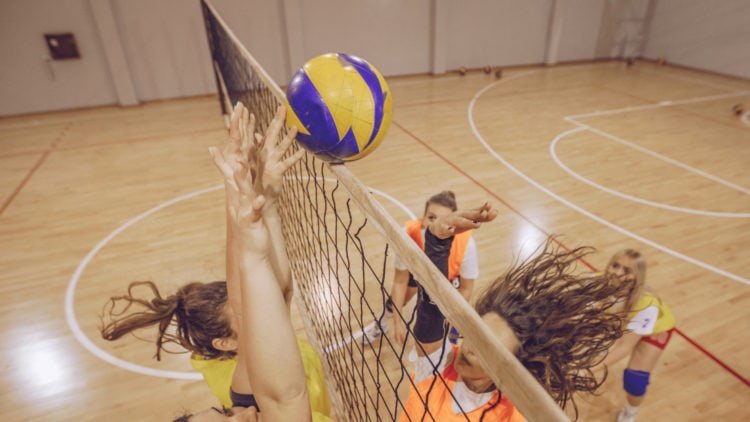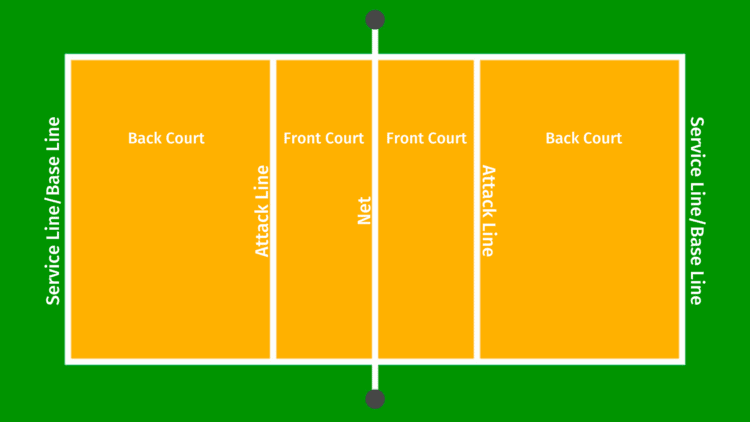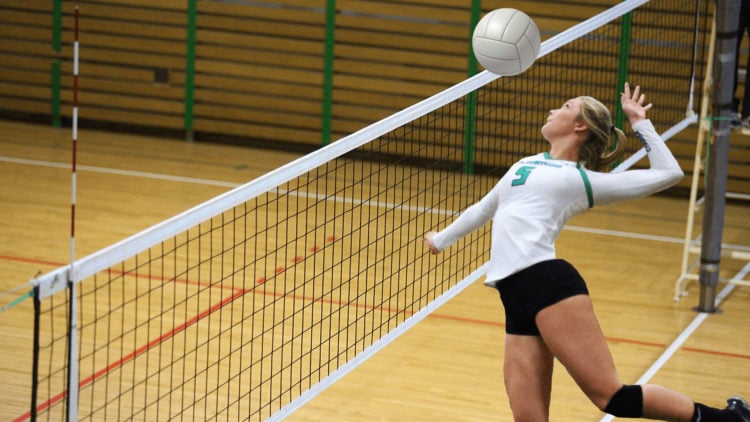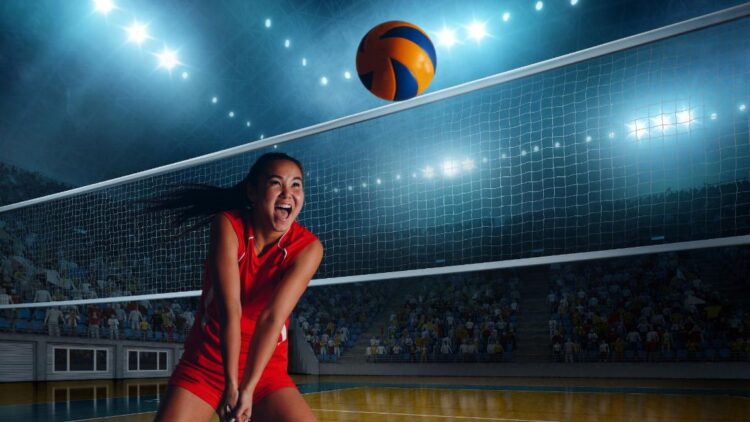
OBJECTIVE OF VOLLEYBALL: Score the most points in a 25-point game by winning rallies.
NUMBER OF PLAYERS: 12 players, 6 on each team
MATERIALS: 1 volleyball, 1 net
TYPE OF GAME: Sport
AUDIENCE: All ages
OVERVIEW OF VOLLEYBALL

Volleyball is a thrilling sport that is super fun to play and watch. The sport is filled with jumps, spikes, dives, and other exciting plays! Although volleyball is a popular sport that is often played recreationally, it is also an official sport with an official set of rules to follow.
Volleyball came to be in the United States in 1895 at a YMCA club in Holyoke. The original name for this sport was Mintonette, and the sport was created as an indoor game that was not too hard to play. However, since players strike the ball and the ball volleys among the players, a professor from Springfield College renamed the sport volleyball.
It’s no surprise that volleyball quickly gained traction and popularity across the United States. And soon after, American troops spread it across the world during World War I. Since the sport was not too strenuous, it became popular amongst women as well.
Since its beginnings in 1895, volleyball has evolved, and it was even featured for the first time in the Olympics soon after in 1964! Nowadays, volleyball is probably one of the most famous sports in the world, with athletes from all corners of the Earth competing in this sport.
In this post, we’ll go over all the rules you need to know about volleyball as well as answer some frequently asked questions. Let’s jump in!
SETUP
Here’s everything you need to know about how to set up a volleyball game, including what the court looks like, the volleyball player positions, and the equipment you need to play.
COURT

The volleyball court measures 59 feet by 29 feet. The court is split in half, with a net going through the middle. The net is 7 feet and 4.5 inches in women’s volleyball and 7 feet 11 inches in men’s volleyball. The boundary line surrounds the entire court, marking the out-of-bounds area. The attack line, or 10-foot line, separates the area near the net from the back court, and the service line marks where the serve needs to be made.
PLAYERS
6 players make up a volleyball team. The players stand in 2 lines of 3 on their side of the court. Here are the volleyball player positions:
- Outside Hitter: Also known as the left-side hitter, the outside hitter hits and blocks from the left side of the court. This player is generally the lead attacker in the offensive. An outside’s responsibilities include hitting from both the front and back row, passing, playing defense, and blocking.
- Opposite Hitter: Opposite to the outside hitter, the opposite hitter balances both offense and defense. Just like the outside hitter, this player must be a good all-rounder, with responsibilities including passing, playing defense, and hitting out of the back row behind the setter.
- Middle Blocker: Also known as the middle hitter, the middle blocker is generally the tallest player and plays from the middle of the court behind the setter. Their main responsibility is to be the first line of defense by raising their arms above the net to block any attacks.
- Setter: The main offensive player, the setter’s main responsibility is to set up the second ball for the hitters to attack. The setter is basically the quarterback of volleyball, as they are in charge of leading the offense. Other responsibilities include playing right-back defense and blocking the opposing team’s outside hitter.
- Libero: Liberos wear a different color jersey and only play in the back row of the court. Liberos cannot attack the ball from above the height of the net and is one of the primary passers. These players are generally quick and agile defenders. Interestingly, when a libero enters the court and replaces a back-row teammate, it is a replacement rather than a substitute, and the exchange does not affect the team’s substitution count.
- Defensive Specialist: The defensive specialist also plays in the back row, but they must abide by the usual substitution rules. Responsibilities include ball control, playing defense, receiving serve, passing, and working with the libero.
EQUIPMENT
You don’t need much in terms of equipment to play volleyball. All you need are:
- Volleyball ball
- T-shirt
- Shorts
- Shoes
- Ankle braces
- Knee pads
- Arm sleeves
- Finger tape
HOW TO PLAY VOLLEYBALL

The goal of a volleyball game is to win serves or score by preventing the other team from returning the ball over the net. As with many other sports and games, such as cricket and ultimate frisbee, a volleyball game starts with a coin toss. The team that wins the coin toss gets to serve first.
SERVING
Each player in a rotational position will serve during the volleyball game. The player in the back right corner of the court is the first to serve. The server must serve from behind the end line or baseline within 8 seconds after the referee has blown their whistle to start the play. The same player will continue to serve the ball until the other team scores a point. The scoring team then gets a chance to serve.
To serve, you should throw the ball up in the air and smack it with the lower palm of your dominant hand. Servers can also jump and serve for more power, serve underhand, or add spin to the serve.
VOLLEYING
After serving the ball, the teams must hit the ball with their hands (or any part of their body above the waist) back and forth across the net until one team faults or fails to return the ball. Each side is allowed to hit the ball 3 times before the ball is hit over the net, but each player is only allowed to hit the ball once. This includes the initial serve. Note that a block is not a hit.
Players can use one or two hands or even their heads to hit the ball after the serve. The goal is to hit the ball over the net and prevent the other team from returning the ball. You can do this by spiking the ball quickly on the other side, jumping up and blocking a ball the other team is attempting to get over the net, or hitting the ball so that it lands in a spot where a player isn’t prepared to hit the ball back.
SCORING

A volleyball game goes to 25 points, and the teams play the best of 5 games. The first team to win 3 games wins the entire match. According to Olympic-style volleyball rules, a team wins a point after every serve. Of course, the main way to score a point in volleyball is to hit the ball on the floor within bounds of the opposing team’s side of the court. However, you can also score points if the opposing team violates any of the below rules:
- Hitting the ball out of bounds
- Hitting the ball into the net and the ball does not go over the net
- Hitting the ball more than 3 times without hitting the ball over the net
- The ball goes under the net
- The server stands over the serving line
- Crossing the penalty line
- Touching the net while rallying
- Making prolonged contact with the ball (carrying)
- A player hitting the ball twice in a row
- Reaching over the net, except when executing a follow-through or blocking a ball that is being returned after the opponent makes contact
- Reaching under the net
- Not serving in the correct order
VOLLEYBALL SUBSTITUTION RULES
Volleyball substitution rules slightly differ according to the level of play, but at the international level, there are only six substitutions per set. Here are the substitution rules to keep in mind:
- Substitutes must stand in the designated substitution area.
- Players can only be subbed in and out for their original position.
- Up to 3 players can be subbed for the same position.
- Libero substitutions are unlimited and do not count towards the team’s maximum allowed substitutions.
- Players can only be substituted between points, that is, during time-outs or at the very start of a set.
- Liberos can only substitute back-row players.
ILLEGAL VOLLEYBALL PLAY: CARRYING VIOLATION
An important rule to keep in mind when it comes to volleyball is that you cannot carry the ball. Basically, in order for the hit to be a legal hit, the ball must immediately leave the player’s hand after initial contact. A referee may call a carry violation if the ball stays in contact with a player’s hand for more than a split second.
Types of carrying violations include:
- Carrying while setting: The setter performs the second touch of the ball, directing the ball for a strike from the third player. But while setting, the ball may remain on their open palm for a second too long.
- Carrying while passing: While passing the ball, the ball may contact the inner elbow, which allows an illegal lift to the ball.
- Carrying while attacking: While rare, it is possible to carry while attacking. A referee may call carry when a player attempts to guide the ball with extended contact with the hand.
VOLLEYBALL TECHNIQUE

So, what are some volleyball techniques you should know? The six most basic and common skills in volleyball are:
- Spiking: A form of attack, spiking is when a player strikes the ball over the net into the opponent’s side of the court with such force that it’s difficult for the opposing team to return it.
- Setting: Setting is crucial in volleyball. The setter runs the team’s offense and sets up the third touch of the ball to score a point via spiking.
- Passing: Passing is the step before setting, where a player passes the ball to the setter.
- Serving: Serving is one of the easier skills or techniques in volleyball since the server has complete control over the ball.
- Blocking: While not as celebrated as spiking, blocking is equally important in volleyball in order to prevent the opposing team from scoring a point.
- Digging: Digging is a defensive bump that keeps the ball from hitting the floor, usually a response to a spike.
When played correctly, volleyball is an incredibly thrilling sport to watch. Here, you can watch some incredible plays in the sport:
VOLLEYBALL VS. BEACH VOLLEYBALL
There are two types of volleyball games: indoor volleyball and beach volleyball. While the two sports undoubtedly share many similarities, they are two distinct sports, with each a separate Olympic event as well! As both sports are fundamentally the same, the rules and objectives of the sports are identical. Both indoor and beach volleyball rules state that you can only use a maximum of three touches, and you must hit the ball over the net in a way that the opponent cannot return it.
In terms of differences, there’s obviously the difference in playing surface, as one sport is played on an indoor court while the other is played on sand! Team sizes also drastically differ between the two sports, as indoor volleyball has 6 players on a team at any given time, while beach volleyball teams only consist of 2 players. Yes, just two!
Other differences between indoor volleyball and beach volleyball include differing rules in:
- Substitutions
- Scoring
- Match structure
- Side changes
- Pace of play
For more on this, check out our full article on beach volleyball vs indoor volleyball.
END OF GAME
Each game ends when one team reaches 25 points. The winning team must win by 2, so if the score is 24-24, a team must score 2 more points to win the game. A match is comprised of 5 games and the first team to win 3 games wins the match. If the match is tied 2-2, the final game is only played to 15 points, but the winner must still win by 2 points.
FAQ
Can You Draw in Volleyball?
No, you cannot draw in volleyball. In a volleyball match, there are generally up to 5 games and a team must win each game by 2 points, so a draw would not be possible.
Is Volleyball an Easy Sport?
Volleyball may seem simple at first glance, but it is a rather physically demanding sport due to its fast-paced nature. To play the sport well, you would need to be at the top of your game both physically and mentally.
Can You Hit a Volleyball Twice in a Row?
No, you cannot hit a volleyball twice in a row. Doing so would result in a point for the opposing team. However, what you can do is have two different players of the same team hit the volleyball one at a time for a total of three hits.
- 23 SUPER FUN 4TH OF JULY GAMES - April 23, 2024
- 30 FUN DATE NIGHT GAMES FOR COUPLES - April 18, 2024
- 200+ INSANE “KISS MARRY KILL” QUESTIONS TO ASK - April 16, 2024